End the Parking Giveaways, Increase Revenue and Reduce Congestion
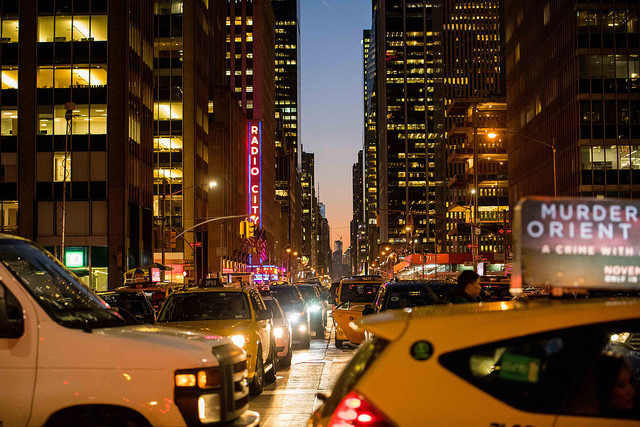
(photo: Benjamin Kanter/Mayoral Photo Office)
New York City’s Department of Finance announced last week that it is moving to reduce the discounts it gives to commercial vehicles through a 15-year-old program that gives companies like Verizon and Fresh Direct a bulk break on parking tickets.
City officials say that the program’s new, higher fees will help reduce congestion by raising the pain for trucks that are double-parked or otherwise blocking traffic, as well as raise revenues by a relatively small amount: $17 million annually. They have sweetened the pill by creating a $120,000-a-year parking czar who supposedly will act as the ticket-payers’ advocate.
But the measure is too little, too late. The problem with the Finance Department’s parking programs -- one is for companies that make short deliveries and another for those with trucks that might stay longer -- is not lack of enforcement; it’s their very existence. New Yorkers should tell their representatives to end, not mend, these inherently unfair, road-clogging, fume-producing programs. A bill pending now in the state Legislature, sponsored in the Assembly by David Weprin (D-Queens), would do that.
Why are the city’s bulk-discount programs for parking tickets so unfair? Aren’t they good for businesses that make deliveries?
Much has changed since Mayor Bloomberg created the programs back in 2003 -- our shopping habits, for one. In the days before massive online shopping, a delivery might be a quick curbside hit by a van. Now, big trucks will park in no-parking zones for hours, as workers unload hand-truck after hand-truck. Traffic crawls around them. Congestion leads to more congestion -- and air pollution, as all kinds of vehicles sit idling.
The parking scofflaws also adversely affect safety for motorists, cyclists, and pedestrians, especially disabled people who must negotiate round the trucks and who depend on unfettered access to parking.
The programs also hurt the little guy. The average citizen does not get to enroll in the programs; we have to fight infractions in hearings or hire agents (like my firm) to do it for us. And higher fees for tickets also will hurt the smaller firms in the program, forcing them to spend more time in court.
The biggest losers may be the taxpayers. The city estimates that it settled almost half of the 3 million tickets incurred by businesses in the programs -- revenues that could have added up to $100 million to city coffers annually. When the city zeroes out tickets through the programs, it also expunges a $15 surcharge on all tickets mandated by the state, which funds anti-drunk driving education, help for indigent defendants, and domestic-violence programs. That deprives the government of another $45 million or so annually.
For all these reasons, these outdated programs amount to corporate welfare we can ill-afford, and they breed cynicism about our traffic laws. Why do some get their fines reduced as part of the cost of doing business, while everyday people pay full freight, so to speak?
Tell your representatives that the meter has run out on these programs.
***
Glen Bolofsky is the CEO of parkingticket.com, a nationwide, web-based service that disputes parking fines.
***
Have an op-ed idea or submission for Gotham Gazette? Email This email address is being protected from spambots. You need JavaScript enabled to view it.
The Contradictions of Cross-Endorsements in the Governor’s Race
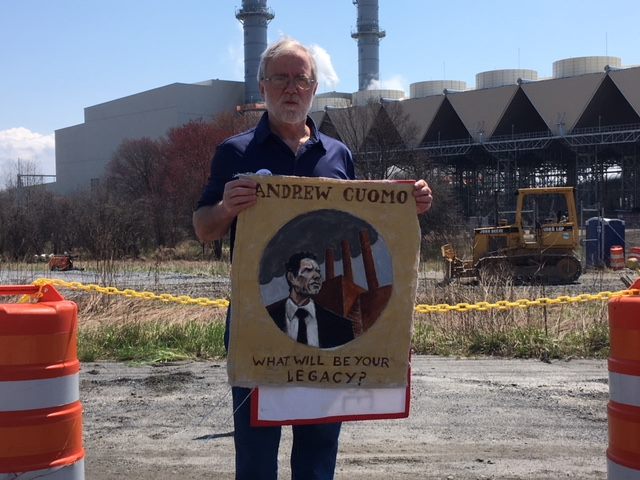
(photo via Facebook: @HowieHawkinsForGovernorPolitician)
That didn’t take long. On Saturday, April 13 the Working Families Party endorsed Democrat Cynthia Nixon for New York Governor. By the following Tuesday, the WFP said they didn’t really mean it.
“We will not be a spoiler,” said Bill Lipton, the WFP’s political director, indicating that the WFP will take Nixon off its ballot line if she loses the Democratic primary against Governor Andrew Cuomo. Perhaps the WFP will offer Cuomo their ballot line for a third time if he wins the Democratic primary – if he will take it.
I feel for rank-and-file WFP progressives. It’s an abusive relationship. They got double-crossed by Cuomo in 2014 when they endorsed him. This year they got strong-armed by Cuomo when they didn’t.
I would like to reassure WFP progressives that, whatever happens in the Democratic primary, the Green Party gubernatorial ticket will offer a progressive alternative in the November 6 general election.
Only three parties – Democratic, Republican, and Green – created their ballot lines by running their own candidates. The other five ballot-qualified parties got the 50,000 votes for governor needed for a ballot line by cross-endorsing the Democrat or Republican. These so-called “fusion” parties function like political clubs inside the major parties, not independent parties.
When the WFP endorsed Cuomo over Zephyr Teachout in 2014, Cuomo’s double-cross began immediately. He backed away the next day from promises he made to get the endorsement in his so-called hostage video to the WFP convention. At the Celebrate Israel Parade the morning after, Cuomo told reporters, “It’s very simple at these political conventions: you either win or you lose. Uh, and I won…At the end of the day I won the endorsement, and that’s what’s really relevant.”
On that morning after, Cuomo broke his promise of the night before to allow municipalities to raise the minimum wage. Asked about his promise to help Democrats take control of the State Senate, Cuomo said, “This is about electing people who support an agenda. I also will oppose Democrats who have opposed things that we have tried to pass."
Over the next nearly four years, Cuomo spent none of his political capital to pressure the Independent Democratic Conference to break its governing coalition with Senate Republicans. Cuomo used the Senate to deflect blame for his failure to enact so much of what he had promised the WFP, including full funding of public schools, the Dream Act, abortion-rights protections, government ethics reform, and public campaign financing. Cuomo played the WFP and took their votes for granted.
So this year the WFP was right to endorse a progressive challenger. Cuomo’s response, according to WFP leaders, was a power play to pull the unions out of the WFP and threaten to cut union and state funding for WFP-affiliated community organizations.
Then there are the scores of WFP-endorsed “Working Families Democrats,” as this nominal third party refers to them, who are running for the State Senate and Assembly. No doubt these Democrats feel pressure from the Democratic machine, and particularly the big Democratic donors who back Cuomo, to endorse Cuomo...or else.
Such are the contradictions of fusion balloting. It would be confusing for the WFP to run Nixon against Cuomo in November when it is also supporting Democrats whose ticket would be headed by Cuomo. Organizing working people to vote for the corporate-sponsored Democrats is like organizing workers into a company union run by the bosses.
The Green Party takes a different approach. We organize working people and progressives into a party that is independent of the Democrats’ corporate donor swamp of real estate barons, Wall Street bankers, media and movie moguls, military contractors, and big pharma and insurance. Our political independence forces Democrats to compete for progressive voters instead of taking them for granted. The Green vote gives us political leverage. We try to win, but we don’t have to win the office to make a difference.
The 184,419 votes for 5% in the general election that the Green gubernatorial ticket received in 2014 reinforced the 192,210 votes that Zephyr Teachout got in the Democratic primary. Cuomo, who had wanted to run up his vote for a presidential run, received a smaller percentage than he had in 2010. Seeking those votes to his left after that election, Cuomo adopted a number of Green demands, from the fracking ban and paid family leave to partial implementation of the $15 minimum wage and tuition-free public college.
Greens will demand more this year, including single-payer health care, fully-funded public schools, a stop to fracked-gas infrastructure, 100% clean energy by 2030, and public campaign finance. And we will still be on the ballot in November.
***
Howie Hawkins, a recently retired Teamster from Syracuse, was the Green Party candidate for Governor of New York in 2010 and 2014 and is seeking its nomination again this year. On Twitter @HowieHawkins.
***
Have an op-ed idea or submission for Gotham Gazette? Email This email address is being protected from spambots. You need JavaScript enabled to view it.
New York City Tourism Industry Deserves Credit for Major Job Growth
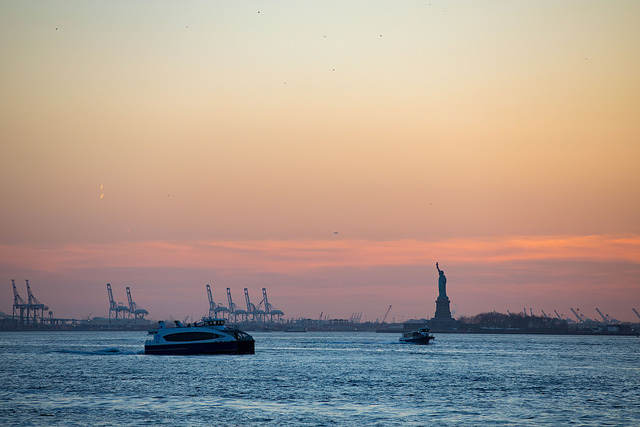
(photo: Benjamin Kanter/Mayoral Photo Office)
Over the past two decades, tourism to New York City has swelled from 33 million to nearly 63 million annual visitors, with powerful ripples throughout the city’s economy. Once just one sector among many, tourism has risen to become one of the top four employment drivers in the city, according to a new report published by the Center for an Urban Future, the Association for a Better New York, and the Times Square Alliance
This spike in tourists has sparked hundreds of thousands of new jobs in hotels, restaurants, retail shops, museums, airports, tour bus companies, and even travel-tech startups. More than 291,000 New Yorkers count on tourism for their jobs—putting it on par with the tech ecosystem, the creative economy, and the finance industry. Better yet, the tourism industry provides real, middle-class jobs with an average annual income of $62,000, outpacing comparable sectors like manufacturing.
Given this new data, the city should make concrete efforts that recognize tourism’s role in the region’s economy. Investments in infrastructure, marketing and promotion, and other commonsense initiatives that make this region more convenient to visit will fuel growth across many job sectors.
The city will need to upgrade its tourism infrastructure. New York has never adequately planned for 60 million tourists a year, and it has not made enough of the infrastructure investments that are needed to sustain this many annual visitors. The city needs to create new solutions for tour bus parking and elected officials should push to modernize the air traffic control system. The city should also create its first long-term tourism plan, with involvement from economic development, planning, and transportation agencies.
Despite the stunning influx of tourists, New York’s tourism sector faces several new and evolving challenges, from the strong dollar to a tourism promotion budget that has not stayed competitive with that of marketing agencies in other global destinations. New York boasts one of the best tourism promotion agencies in the world, NYC & Company, but the city should increase its budget to support its important mission and bolster the tourism industry citywide.
With tourists accounting for roughly 70 percent of passengers at JFK Airport and 50 percent at LaGuardia, the Port Authority should continue its work to improve the airport experience. The agency has made important investments in recent years, but should consider new initiatives like free WiFi in all airports, and more multilingual staff and wayfinding signage in terminals to support and encourage tourism.
New investments in infrastructure and a more welcoming environment for tourists would have resounding effects across the economy. Tourists are responsible for 24 percent of all Visa credit card transactions at the city’s restaurants and bars, and make nearly one-fifth of all purchases at the city’s retail stores, a crucial boost as many retailers face increasing pressure from online competition.
Out-of-towners are also fueling the growth in attendance at cultural institutions—and the job gains that have come with it. Tourists now comprise 73 percent of visitors to the Museum of Modern Art, 70 percent of visitors to the Whitney Museum of American Art, and 60 percent of the Metropolitan Museum’s visitors. The city’s museums and historical sites have added 4,500 jobs in the past 15 years—an 86 percent increase.
With a billion people poised to join the ascendant global middle class, opportunity lies ahead for New York City’s tourism economy—along with thousands of new jobs. But channeling sustainable growth in the future will require increased planning and a new way of thinking about the 60-plus million annual tourists that the city has today.
***
Jonathan Bowles is executive director of the Center for an Urban Future. Angela Pinsky is executive director of the Association for a Better New York. Tim Tompkins is president of the Times Square Alliance.
***
Have an op-ed idea or submission for Gotham Gazette? Email This email address is being protected from spambots. You need JavaScript enabled to view it.
To Maximize Affordable Housing, Increase Collaboration Between Public and Private Sectors
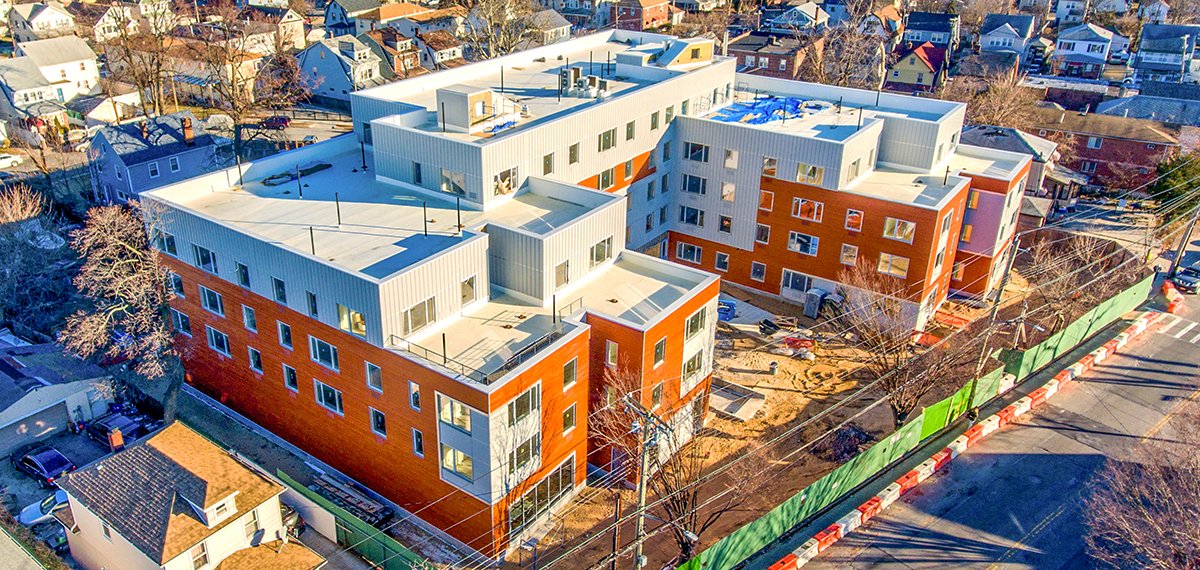
(photo: @NYCHousing)
The millions of New Yorkers struggling to deal with impacts of an urgent housing crisis deserve to see more collaboration between government officials and industry leaders who have the power to provide more affordable homes for low- and middle-income families.
Fortunately, the recently-passed state budget provides a reminder of what can be achieved when public officials advance smart, pro-housing policies with appropriate input and feedback from local leaders and those who build and preserve affordable housing. Alongside ongoing positive strides at the city level, New York City is well-positioned to further address its housing crisis and truly turn the tide in the months and years to come.
Just as importantly, this roadmap for crafting public policy – driven by an ongoing dialogue between the public and private sector – will help New York to more effectively mitigate recent changes at the federal level that have created some new challenges to maximizing affordable housing production.
Aside from continuing to advance New York State’s multi-billion-dollar commitment to financing affordable housing construction and preservation, the new state budget includes two prime case studies that demonstrate the benefits of increasing that kind of collaboration.
First, the state approved changes that will allow builders of affordable housing to utilize State Low-Income Housing Tax Credits (SLIHTC) separately from federal LIHTC. Previously, those credits could only be used together, even after recent federal tax cuts led to a devaluation in federal credits that made it harder to finance low-income housing.
Sensing the long-term implications of this challenge, NYSAFAH raised the issue directly with state lawmakers and administration officials. The result was a commonsense, pro-housing decision to split up, or bifurcate, the state and federal tax credits and to certificate the state credits – and these simple moves will attract millions in additional private financing for affordable housing each year, at no cost to the state.
Another area of fruitful collaboration involved a different issue regarding tax credits. The initial state budget proposal included a provision that would have deferred the use of several different credits – which play a crucial role in the production of affordable housing – for at least the next three years, and devalue the credits for a far greater period.
Again, NYSAFAH and other stakeholders understood from our experience on the ground that this was an area of tremendous concern. Taking pivotal tax credits off the table would have made it impossible to build and preserve affordable housing in communities that need it most.
And again, the conversations with and persistent advocacy before state officials led to a successful outcome – the tax credits were preserved and the affordable housing pipeline will continue to produce homes for low-income New Yorkers.
Together with the ongoing work at the local level, these statewide advances should demonstrate to all policymakers and stakeholders that open, fact-based dialogue is one of our best and most valuable tools in the fight to confront New York’s affordable housing crisis.
As NYSAFAH welcomes leaders from across the public and private sectors to its 19th Annual New York City Conference in the days to come, we have every reason to believe that these positive discussions will continue. And that is good news for all New Yorkers.
***
Jolie Milstein is president and CEO of the New York State Association for Affordable Housing (NYSAFAH). On Twitter @NYSAFAH.
***
Have an op-ed idea or submission for Gotham Gazette? Email This email address is being protected from spambots. You need JavaScript enabled to view it.
The Mayor’s Much-Needed Investment in Culturally Responsive Education
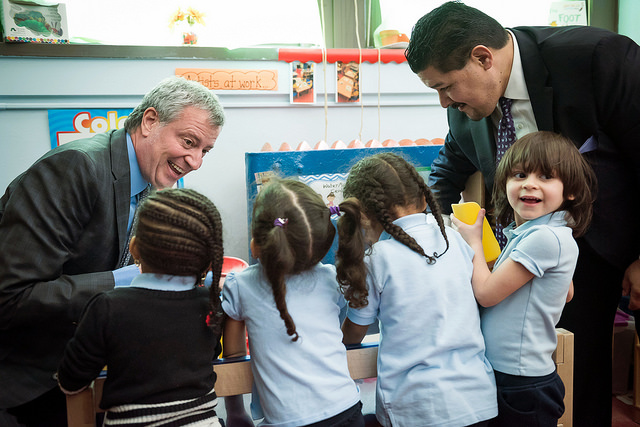
Mayor de Blasio & Chancellor Carranza visit a school (photo: Ed Reed/Mayor's Office)
Mayor Bill de Blasio’s announcement last week that the City is investing $23 million in culturally responsive education and anti-bias training in schools -- likely the largest investment of its type nationally -- is welcome news for New York City parents, educators, and researchers.
Education researchers have long-known that culturally responsive education (CRE) -- the practice of aligning curriculum and instruction with students’ backgrounds, life experiences, and cultures -- has a positive impact on improving student outcomes, especially for students of color. Just in the past two years, research has shown growth in student outcomes from having Black teachers, fostering positive racial identity, and taking Ethnic Studies courses.
Results from a new survey concur. They show that New York City teachers are eager to use CRE as a strategy to improve educational outcomes. According to the survey of nearly 400 city public school teachers conducted by the NYU Metro Center, a majority of teachers believe that CRE would improve their practice. However, a lack of preparation and expertise has limited the extent to which teachers can put CRE to practice.
The vast majority of respondents (87%) felt that teachers are responsible for helping students acquire the skills to critically understand, analyze, and respond to issues related to race and ethnicity. An even greater majority (93%) said they would be willing to modify their lessons to connect with students of diverse racial and ethnic backgrounds.
Until now, support for teachers to do this has been scarce, both in teacher preparation programs and in professional development offerings. Fewer than one in three (29%) of the teachers surveyed reported that they receive ongoing professional development on issues of race and ethnicity in the classroom, and only 10% indicated that they rely on the city Department of Education for this support. When tensions related to racial, ethnic, sexuality, or other identities arise between students inside schools, over half (55%) of respondents said they felt unprepared to intervene, and 93% said their colleagues would be unprepared to intervene.
The mayor’s announcement can begin to change that.
However, the city’s program must become bolder. In order for them to actually shift their practices to teach more effectively across differences, teachers will need a program of deep, ongoing training – not just a one-day workshop. Unlearning biases, being reflective about one’s identities, reconstructing curricula that are sustaining and relevant to students, and bridging the distance between student and teacher does not happen overnight.
Survey respondents call for more training on integrating race and ethnicity into their lessons, more resource materials, and more opportunities for relevant discussions with colleagues. They will need ongoing support to work effectively across lines of race and ethnicity, to ensure that teaching and learning is culturally responsive for all our children, and that teachers are culturally competent to teach them.
In this time of heightened visibility and awareness of racial bias in education, teachers are eager for ways to reach beyond differences to close gaps not only in student achievement but also between student and teacher. Schools Chancellor Richard Carranza, with his extensive history and track record with bridging cultural divides, is the right leader to make New York City a national model in the area of culturally responsive education.
We hope that New York City can now finally and truly make culturally responsive education the core of its strategy for educating all students, particularly those most implicated by cultural bias.
[Access the full survey findings here.]
***
David Kirkland is the Executive Director and Jahque Bryan-Gooden is a Research Analyst at the NYU Metropolitan Center for Research on Equity and the Transformation of Schools.
***
Have an op-ed idea or submission for Gotham Gazette? Email This email address is being protected from spambots. You need JavaScript enabled to view it.
City, MTA Must Look Under the Hood for Greater Climate Progress
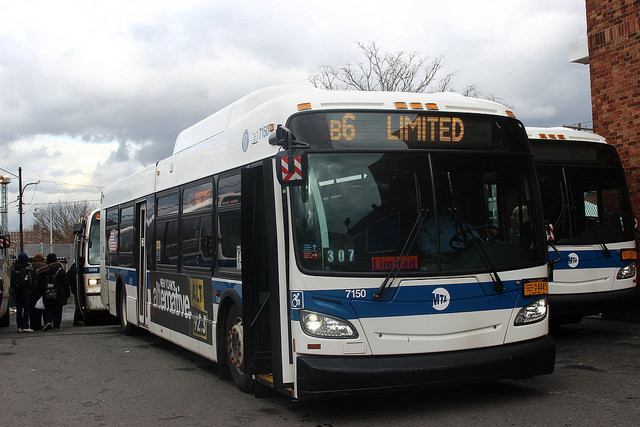
An MTA bus (photo: MTA Bus)
The new congestion pricing surcharges on taxis and on-demand ride services below 96 Street in Manhattan are designed to address congestion in midtown, but they generate more controversy than impact. They might raise a few hundred million dollars a year for the MTA to fix the subway. But they won’t do anything to reduce congestion or air pollution. Meanwhile another big ticket MTA budget item has gotten little attention but will have a huge impact on New York City's emissions, air quality, and public health: bus procurement.
The MTA plans to spend over $300 million this year and $1.38 billion over the next four years to buy about 1,700 new buses. Some 1,300 of them – roughly a billion dollars’ worth – are slated to be diesel-fueled, and therein lies the rub. Diesel vehicles were powerful and efficient for the 20th century, but they are big polluters. Much better 21st century alternatives exist.
Analysis by Energy Vision recently submitted in testimony to the City Council shows that diesel buses and trucks on our streets generate a disproportionate share of adverse impacts on New York City’s climate, air quality, and health. Across the City’s municipal fleets, its 10,000 medium- and heavy-duty trucks consume 60% of the fuel, emit 63% of GHGs, and are a major emitter of health-damaging nitrogen oxide (NOx) and particulates (PM). Thousands of MTA diesel buses compound the problem. According to Dr. Philip J. Landrigan, head of Global Health at Mt. Sinai, eliminating diesel buses and trucks from our fleets would reduce New Yorkers' childhood asthma, heart disease, lung cancer, strokes, and health care costs.
New York City has ambitious goals for achieving the best air quality of any major U.S. city by 2030 and for cutting GHGs 80% from its municipal fleet vehicles by 2035. This year Mayor de Blasio announced the City would go “fossil free” by divesting its pension funds from fossil fuel stocks. Realizing these ambitions is vital for the climate, our health, and our kids' futures. But there is little chance of that if the City and the MTA continue to purchase more heavy-duty diesel trucks and buses.
The MTA will buy 110 new natural gas buses this year, which is significant. But its fleet of 5,700 buses already includes over 4,500 diesel buses, plus the 1,300 new diesels it plans to buy over the next four years.
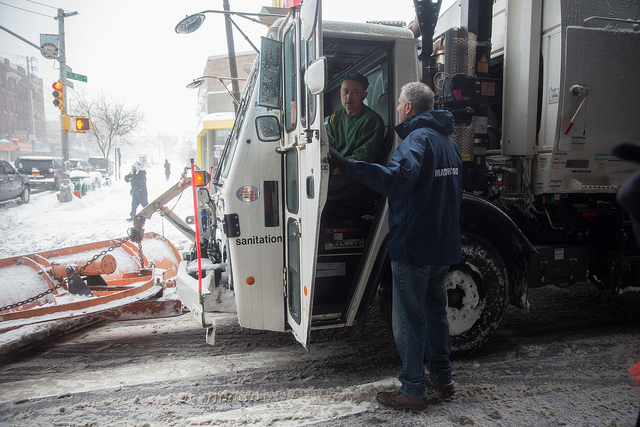
The City Department of Sanitation (DSNY), which operates the largest refuse fleet in the country -- more than 2,200 collection trucks -- runs virtually all of it on biodiesel, which is 80% ordinary diesel fuel. It has just 42 natural gas trucks, and it buys hundreds more diesel refuse trucks every year.
We can do better. New York is now far behind other world-class cities in weaning itself off diesel. London has already stopped procuring diesel vehicles for its fleets as of this year because of their health and climate impacts. Eleven other major cities are pledging to follow its lead, including Oslo, Rome, Beijing, and Shanghai.
In fact, New York City is one of those 11. The MTA and the City can and should start phasing out diesel vehicles now.
The questions are, what alternatives should replace them and how fast could they ramp up? The MTA is piloting electric buses, which are quiet and have zero tailpipe emissions. But they cost a whopping $300,000-$400,000 more than diesel per vehicle. The City is aggressively deploying light-duty electric vehicles and charging infrastructure, but electrification of its heavy-duty trucks is not yet a commercial option, especially for refuse trucks, since they don’t have enough power to both collect garbage and plow snow.
There’s a better way to decarbonize New York’s heavy vehicles. The MTA and the City could do what other cities are doing: buy more natural gas (CNG) buses and trucks equipped with efficient engines that cut emissions and can run on renewable fuel.
The new “Near Zero” natural gas engine, certified by the U.S. EPA, has taken clean burning to a new level. It cuts health-damaging nitrogen oxide and particulate emissions 90% below the EPA’s most stringent standard. Near Zero buses and trucks are only about $50,000 more than their diesel counterparts. They are just as powerful and serviceable and are 50-80% quieter than diesel engines.
They can run on conventional CNG, but even better, they also run on biomethane or Renewable Natural Gas (RNG). RNG is chemically similar to conventional natural gas, but it is not a fossil fuel. It’s made from a renewable resource: organic waste, such as food waste from homes and businesses, the sewage that goes to wastewater plants, agricultural manures, and more. Instead of drilling, RNG is produced by collecting and refining the methane biogases emitted by those organic wastes as they decompose, in special tanks called “anaerobic digesters.”
The resulting fuel isn’t just clean-burning; it is the lowest-carbon fuel available. When made from food waste or animal manure, it is actually net carbon-negative over its lifecycle. In other words, making it captures more greenhouse gases (which would otherwise escape into the air as the waste breaks down) than are emitted by the vehicles burning it for fuel. There’s no faster, more cost-effective, or climate-friendlier way to cut fleet emissions.
The MTA already has 800 buses and DSNY already has 42 refuse trucks that use conventional CNG. With a simple change in fuel contracts they could run on RNG overnight. The RNG could be delivered through the same natural gas refueling stations that now supply conventional natural gas, and at the same price.
There is plenty of RNG available in the U.S. Over 40 projects are processing decomposing organic wastes into vehicle fuel across the country. More are under development in the New York region that could make fuel for our municipal fleets from our own waste streams. The roughly 1.2 million tons of food waste generated in New York City each year could make enough RNG to power all the trucks in the City’s fleets, turning a costly waste burden into a valuable energy resource.
Nationwide, there is enough RNG production potential to power the refuse, bus, and airport fleets of every major U.S. city. Some 20,000 buses and trucks across the country now run on RNG. Los Angeles Metro has purchased 295 RNG-fueled “Near Zero” buses, with an option to convert its entire 2,200 transit bus fleet. Santa Monica’s “Big Blue Bus” fleet converted to RNG completely, and more municipalities are following suit.
So what is New York City and the MTA waiting for? Getting our heavy vehicles off diesel is the single biggest step we can take toward a sustainable transportation sector, and would propel us toward meeting the City’s clean air, climate, fossil fuel elimination and waste prevention goals. It’s high time we got started.
***
Joanna D. Underwood is founder and board member of the national environmental organization Energy Vision, which researches, analyzes and promotes viable technologies and strategies to transition to a sustainable, low-carbon energy and transportation future. On Twitter @Energy_Vision.
***
Have an op-ed idea or submission for Gotham Gazette? Email This email address is being protected from spambots. You need JavaScript enabled to view it.
Driver’s Licenses for All Would Better Many Lives, Including Mine
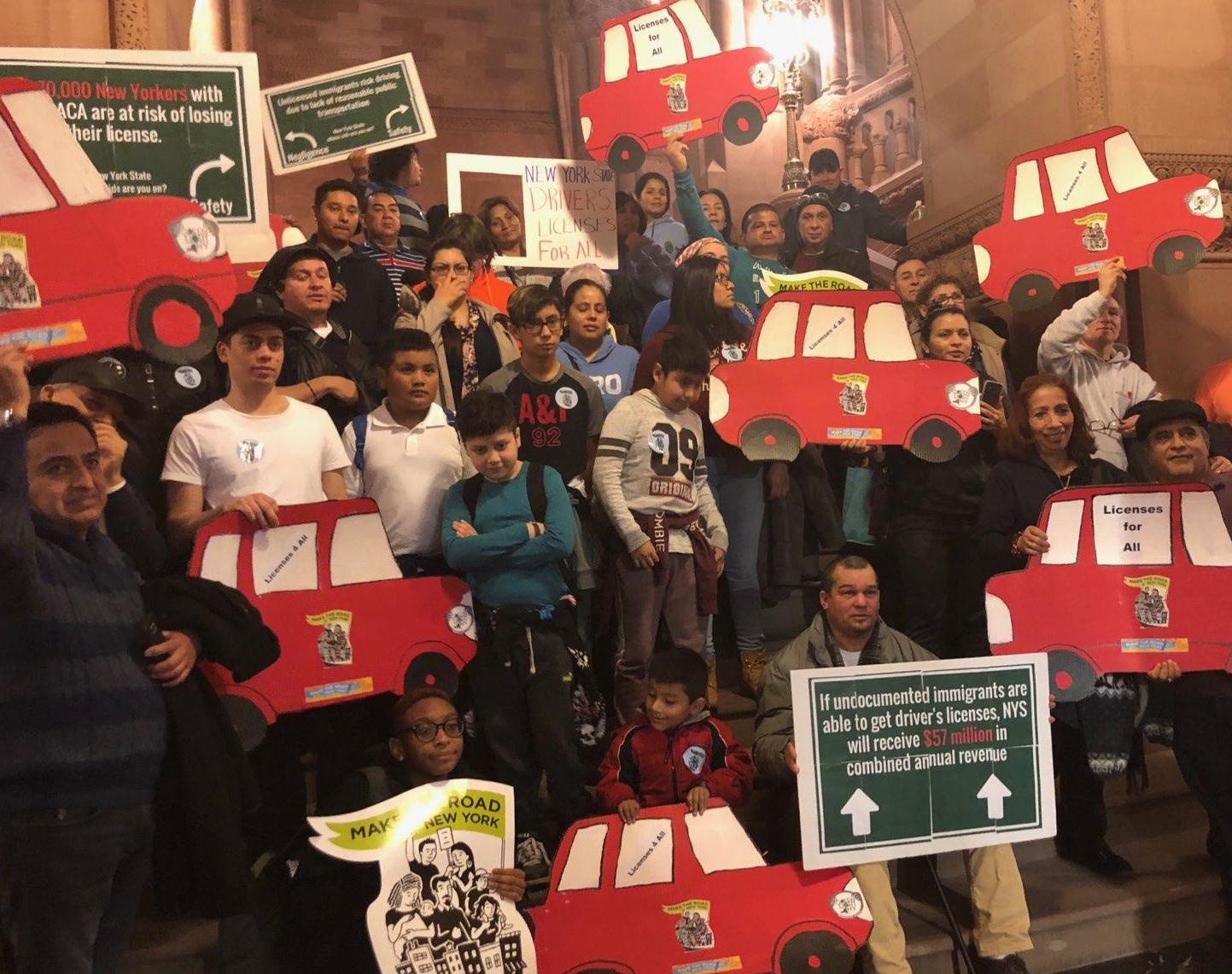
Make the Road New York members rally in Albany for driver’s licenses for all
Every morning, I drive with my wife to work. My commute is the scariest part of my day - and not because of the traffic. It’s because I know that a routine traffic stop could lead to me being separated from my family forever.
I’m an undocumented immigrant, and New York will not currently allow me to get a driver’s license. For New Yorkers like me, it’s way past time for our state to step up and do what other states have done: ensure that all qualified drivers, regardless of immigration status, can have access to a license.
The attacks by the Trump Administration continue to get worse. Trump’s Immigration and Customs Enforcement (ICE) officers are using every excuse to detain and deport immigrants alike and tear us from our families, as they did in detaining 225 immigrant New Yorkers one recent week. They’re especially using minor traffic violations.
That’s why I recently joined fellow immigrants and advocates from across New York State to call on the State Legislature -- starting with the Assembly -- to restore access to driver’s licenses to all New Yorkers.
This bill would change my life, and my family’s too. I have lived in the United States for nearly 20 years and I wish I could be eligible to adjust my immigration status, but at the moment due to our current broken immigration system, that is not possible. There is no clear path for me to be able to adjust my immigration status, but other measures can be helpful to me and others like me.
I live in Long Island with my wife and two children. Every day, I leave my house to drive to work, with uncertainty and fear. Where I live, there is a lack of public transportation. It can take hours to get anywhere by bus or train, and taking a taxi is too expensive. I have to drive because I cannot afford to be late to my job and I need to be able to go to the store, take my children to their doctor appointments, and pick them up from school.
I was once stopped at a traffic stop by police. I was given a ticket for driving without a license and needed to go to court. I couldn’t sleep due to the fear I felt of going to court and possibly being separated from my family. I went to court and, with the legal fees of my attorney, I ended up paying almost $700. Thankfully it wasn’t worse than that -- and it now easily could be.
In my home country in Latin America, I had my driver’s license, but right now, due to my immigration status, I am not able to get a driver’s license in New York State.
Expanding access to driver’s licenses to all New Yorkers makes sense. If it passes, immigrants will be able to register, and insure their vehicles in New York, creating an economic boost. A 2017 analysis by the Fiscal Policy Institute determined that New York would receive an estimated $57 million in combined annual revenue.
Allowing driver’s licenses for all will improve public safety by making sure that all drivers on the road are licensed. States like California have already been experiencing the positive effects of granting undocumented immigrants access to driver’s licenses since 2015. A Stanford report released last year found there had been a significant decrease in hit-and-run accidents.
At a time when the Trump Administration’s attacks on our communities continue, passing this legislation would demonstrate that New York stands up for everyone, regardless of their immigration status. New York has delayed too long; we need to do more to stand against the White House anti-immigrant rhetoric now.
Obtaining a driver’s license will change my life, my family’s life, and that of thousands of New Yorkers. It would mean being able to pick up my children from school or take them to the doctor without fear. And it would help me to potentially get a promotion at my current job, or be able to look for better one.
There are 12 states, including Connecticut and Maryland, that currently allow undocumented immigrants access to driver’s licenses. The new governor of our neighboring state, New Jersey, has committed to follow those states and expand access to driver’s licenses. But we haven't heard a commitment from Governor Cuomo yet. New York should be next.
***
Jorge Cotraro is a Long Island resident and a member of Make the Road New York, the largest grassroots community organization in New York offering services and organizing the immigrant community. On Twitter: @MakeTheRoadNY.
***
Have an op-ed idea or submission for Gotham Gazette? Email This email address is being protected from spambots. You need JavaScript enabled to view it.
State Budget Does Help Mass Transit, But MTA Capital Plan Uncertainty Rising
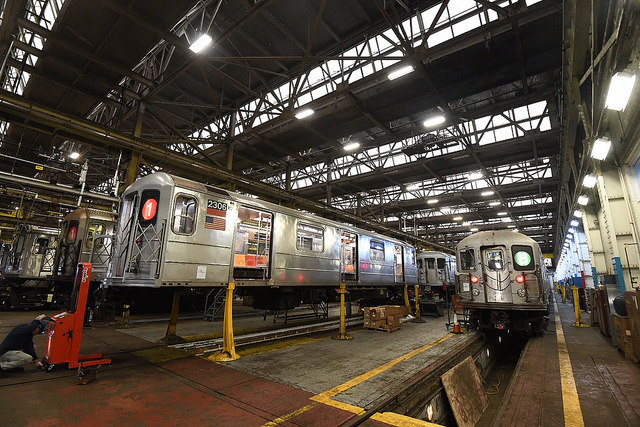
(photo: Don Pollard/Governor's Office)
The MTA received two significant infusions of new money in the state budget effective April 1. The first is the full $836 million, to be provided to the MTA by December 31, to fund phase one of the Subway Action Plan developed last July by Chair Joseph Lhota and MTA management. The second is through a new tax, starting January 1, on for-hire vehicle trips by taxis, Ubers, Lyfts, and others for trips in Manhattan south of 96th street. The tax revenue will put an estimated $400 million a year into the MTA budget to provide regular, ongoing support for the increases in maintenance related to the Subway Action Plan.
The new money is very welcome for the beleaguered transit system, but major policy and funding questions like the MTA’s long-term capital construction program and whether a congestion pricing program will become integral to future sources of funds remain unanswered.
The $836 million to be delivered in 2018 is a combination of about $500 million in operating funds to cover the expense of several thousand new maintenance positions in subway car overhauls, replacing track and signals, deploying emergency personnel, and other staffing, with the rest investments in related physical assets. Half the money for the 2018 infusion was initially put into the proposed executive budget submitted by Governor Cuomo to the Legislature from state funds. The State Legislature agreed to that and also to compel the City of New York to come up with the other half of the funds, $418 million, despite Mayor de Blasio’s objections to the city being required to provide the money when proposed last year after Governor Cuomo declared a transit emergency. The ongoing deterioration of subway service that led to the emergency declaration impelled the Legislature to agree that both the State and the City must provide additional support to the MTA.
Two other proposals in the budget by the governor to force New York City to pay even more money to the MTA were rejected by the Legislature, with the Assembly specifically denying the approvals in both its one-house budget and later in its summary of the enacted budget. These proposals were viewed as far more onerous than the Subway Action Plan mandate. One required the city to pay the full cost of the New York City Transit Capital Plan, which is supposed to be $17 billion over the five years of the current 2015-19 MTA plan. Right now the city’s scheduled contribution is $2.5 billion.
The second proposal would give the MTA the authority to determine how much property tax revenue in New York City it could take from “value capture.” This budget bill would allow the MTA to decide how much property tax value is added due to transit improvements it makes in certain zones around the city, and then direct the incremental property tax revenue to itself without the city having a right to approve it, or even have a say in how much money is involved. The Citizens Budget Commission called this proposal “confiscatory.“ Although rejected, versions of these proposals are likely to resurface in the future as the Cuomo administration tries to find ways to shift financial responsibility from the state to the city to fund the MTA.
The State Assembly deserves thanks from the public for the $400 million for-hire vehicle trip surcharge for mass transit. Governor Cuomo never put legislation to create a congestion pricing plan into his proposed budget, despite endorsing the concept last summer and creating the Fix NYC Advisory Panel, which offered a congestion pricing framework in a report that was released at the time of the budget. However, in early March the State Assembly, in its one-house budget, proposed the surcharge to fund the recurring maintenance program. A similar surcharge had been a lesser part of the Fix NYC report, which called for a three-year, three-phase program, the main element of which is a charge to enter Manhattan south of 60th Street for most vehicles, designed to yield up to $1 billion a year. But Governor Cuomo put none of it into his budget plan.
Governor Cuomo had the good sense to rapidly endorse the Assembly’s trip surcharge, and it was approved by the Senate after the tax was limited solely to Manhattan, with no new charges in the outer boroughs or the suburbs. But there is no other element of a congestion pricing set-up. There is no funding for any infrastructure to electronically record entries into the Manhattan business district, which is phase two of the Fix NYC plan. Existing technology in the taxi and for-hire vehicle industry will pinpoint when those vehicles traverse Manhattan south of 96th Street.
Congestion pricing remains in limbo, even as the MTA’s long-term capital construction budget may unravel. In March of this year Standard & Poor downgraded the MTA’s bond rating one notch after an MTA report showed the agency would have a $400 million operating deficit in 2020 and a $600 million operating deficit by 2021, even after two fare and toll hikes. The primary cause of the deficit was reported to be a drop in real estate transaction revenues like the mortgage recording tax, which in part are dedicated to mass transit.
The $32 billion 2015-19 MTA Capital Plan, to which the MTA is now committing significant funds as it finally wraps up the prior plan, includes $11 billion from the MTA itself, primarily from money it will borrow. The forecasted deficits, however, are very likely to constrain the ability of the agency to actually borrow that much money. Not only that, but state government’s share of the 2015-19 Capital Plan, $8.5 billion, included $7 billion for which there was only an I.O.U. with no stream of revenue to back it up. Shortfalls in the 2015-19 Plan could materialize soon, just as discussions about the next five-year capital plan are moving forward.
The MTA has to propose its 2020-2024 Capital Plan in October 2019. The recent five-year plans have cost about $30 billion each - but if the current plan begins to unravel the 2020 plan will be in trouble. A fall 2017 State Comptroller report expressed concern that the 2020 plan might have shortfalls (meaning lack of sources of funding to pay for projects) similar to the $15 billion shortfalls that plagued decision-makers for both the 2010 and 2015 plans before funding schemes were patched together.
The public and the State Legislature need critical information from the MTA very soon to determine the agency’s ability to sustain a meaningful capital program. In 2007 the Legislature made the MTA accelerate submission of its capital plan at that time, earlier than the law had provided, and it could do so again, scheduling a submission for early 2019, rather than the end of the year, to get a better handle on what the problems really are.
Congestion pricing involves rational policy proposals to deter vehicles from entering Manhattan to reduce pollution and congestion, and provide a long-term funding stream for the MTA. But this is the second time in ten years a push for congestion pricing has not been successful in the State Legislature. If congestion pricing won’t fly there is no shortage of possibilities for taxes to fund the mass transit system. There are payroll taxes, personal income taxes, corporate income taxes, sales taxes, millionaires’ taxes, mansion taxes, you name it. The issue is the political will. A consensus on funding this most vital of services remains frustratingly elusive, along with the leadership to forge that consensus.
***
Jim Brennan was a member of the New York State Assembly for 32 years, where he chaired four committees. On Twitter @JimBrennanNY.
***
Have an op-ed idea or submission for Gotham Gazette? Email This email address is being protected from spambots. You need JavaScript enabled to view it.
Byford's Big Bus Plan Relies on City, State Cooperation
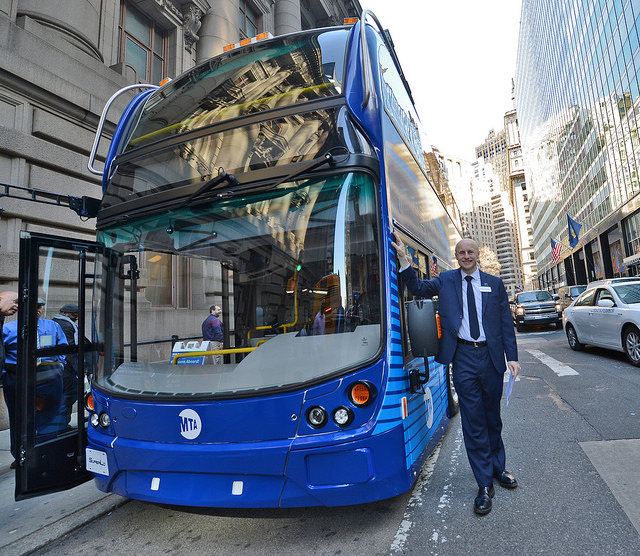
(Credit: Marc A. Hermann / MTA New York City Transit)
In the Big Apple's transit circles, Andy Byford has quickly become the hottest London import since the Beatles. New York City Transit's new president, brought in this winter from his job as the head of the Toronto Transit Commission, faces the unenviable task of fixing the city's ailing subway system and restoring faith in its vital transit network. Just three months into the job, Byford is moving at a breakneck pace, and on Monday, he unveiled an ambitious plan to speed up New York City's snail-like local buses and fight the tide of declining ridership.
The plan sets the bus system on the right road toward improvement but will require city and state cooperation and a change in NYPD culture, two elements in short supply these days that could torpedo Byford’s best efforts. It is also likely to require more money, which is also in short supply.
The New York City bus system is a curious thing. It is notorious unreliable with buses that crawl through city streets stopping every two or three blocks and with average speeds that barely exceed eight miles an hour. With infrequent and unreliable service, ridership has declined by nearly 10 percent since 2012 and 15 percent since 2002. Still, over 2 million riders a day rely on the city's buses, and the bus system needs to be fixed.
Byford's bus plan comes after nearly two years of heavy lobbying from the Bus Turnaround Coalition, a joint effort by the Transit Center, Riders Alliance, Straphangers Campaign, and Tri-State Transportation Campaign. In 2016, this group called for an overhaul of the way buses work in New York City, and in 2018, Byford acknowledged its work in unveiling his plan. "We’ve listened to our riders’ concerns," he said, "and are working tirelessly to create a world-class bus system that New Yorkers deserve."
So what exactly is the plan? For now, it is an aspirational approach to better bus service with a 28-point agenda.
Byford wants to redesign the network by optimizing routes based on ridership needs while eliminating some stops to speed up service and expand off-peak bus frequency. He wants to implement infrastructure upgrades that prioritize buses over other vehicles, including dedicated lanes and a signal prioritization system that allows buses to hold green lights or shorten reds. He calls for NYPD cooperation and effective traffic enforcement, and he proposes a faster boarding process, currently a main source of delays.
To reduce bus dwell time -- the minutes a bus spends sitting at a stop while riders dip their Metrocards or scrounge around for $2.75 in nickles, quarters, and dimes -- Byford suggests all-door border, similar to London's bus system; a tap fare payment card; and cashless bus fares. The final parts of the plan involve customer-focused improvements including more real-time bus countdown clocks, redesigned system maps, and more bus shelters along with some clean-tech buses to replace New York's current gas-guzzlers.
On its surface, the plan is exactly what New York needs. Byford has shown that he understands the problems and drawbacks with the current bus network and is willing to propose a multi-part solution that involves every stakeholder and seemingly transcends the dysfunctional politics of the relationship between the city and state. But unfortunately with such an aggressive plan in play, each of these stakeholders are going to have to work together for this bus revitalization effort to succeed.
And to that end, except with respect to the all-door boarding and other technological upgrades to the buses themselves, Byford is now almost a bystander as he has shifted the onus to the city Department of Transportation, the NYPD, and Albany lawmakers to work together to realize his vision of a better bus network.
Let's start with the city's Department of Transportation. Since DOT controls the city's streets, any changes to the way street space is allocated will have to start with DOT. Thus, additional bus lanes, dedicated bus corridors and the queue-jumping benefits of signal prioritization require DOT buy-in and support, and so will reducing the number of bus stops and changing street design to better support bus infrastructure. NYC DOT Commissioner and MTA Board member Polly Trottenberg voiced support for the plan during Monday's meetings, but her boss, the mayor, a reluctant and infrequent transit rider who virtually never takes the bus, will have to be a forceful ally supporting these changes.
And then we have the NYPD. Currently, the NYPD seems to view the city's bus lanes as, well, parking spots. Take a ride down the East Side's avenues, and bus lanes will inevitably be filled with cops who have decided to park in curbside bus lanes, thus negating their intended purposes. The MTA, on the other hand, expects cops to be willing partners in enforcing bus lane restrictions and generally helping to ensure that other vehicles are not in the way of buses, impeding speeds and progress through congested city streets.
But cops alone are a poor and inadequate enforcement method, and NYPD culture is tough, if not impossible, to change. Thus, Albany takes center stage as bus lane enforcement should be automated and camera-based. Until now, the state Legislature has resisted giving the MTA carte blanche ability to install cameras that can assist in automated bus lane enforcement, but to truly tackle the problem of cars in bus lanes, Albany will have to act, and forcefully.
Finally, the elephant in the room is the cost. We do not yet know how much the bus plan will cost. It relies in part on moving pieces that are funded (such as a new fare payment system) and others that are not, and it will again be up to the governor to champion transit improvements in New York City so that they receive adequate funding. Facing the pressures and, more importantly, the headlines of a primary challenge, Andrew Cuomo has lately embraced certain positions he has rejected in the past, and mass transit support should be one of them. Perhaps, then, the time is right for the city and state to prioritize bus travel over car traffic.
Ultimately, the buses need fixing, but more importantly, the bus system needs to work efficiently so that New Yorkers have faith in it again. Buses can solve access problems in transit deserts and can be a part of the transit upgrades that a true congestion pricing plan would require. Byford has a vision that will improve bus service, but that is the easy part. Now he just has to convince everyone else to join him as well.
***
Benjamin Kabak is the editor of Second Ave. Sagas, on Twitter @2AvSagas.
***
Have an op-ed idea or submission for Gotham Gazette? Email This email address is being protected from spambots. You need JavaScript enabled to view it.
A Doctor’s Perspective: Marijuana Legalization Now

(photo: Cannabis Doctors of New York)
New York’s Compassionate Care Act went into effect in January 2016. As the CEO of Cannabis Doctors of New York, a group based in Manhattan, I’ve been at the forefront of treatment using cannabis and have seen the life-changing results its thoughtful and judicious use can provide. Prescription marijuana medication has helped my patients safely cope with a variety of serious ailments such as cancer, AIDS, chronic pain, and Inflammatory Bowel Disease. However our state’s marijuana policy is about to be quickly surpassed by the policies of our neighbors to the east, west, and north in ways that would hit the New York Metropolitan Area particularly hard.
I am urging lawmakers to consider the unfairness of this situation. All law-abiding New Yorkers should be able to have access to the analgesic and other therapeutic qualities of cannabis. Used responsibly, marijuana can be a powerful and important tool in a healthy lifestyle. And it is a vastly better alternative to the drug scourges eating away at our society. For thousands of years the many uses of cannabis have been woven into societies around the world. There has never been a documented overdose.
Meanwhile, a growing body of research proves that cannabis is an effective tool in safely treating ailments that are now being treated with opioids and in fact, it is being shown to help wean patients off narcotics. As a doctor, I’ve seen these results.
Some 9,000 New Yorkers overdosed on opioids last year. Tens of thousands of Americans lose their lives every year due to alcohol — a legal yet far more dangerous substance than marijuana. Enough is enough. It’s time for New York to join the 21st century and pass the pending legislation that would expand the current medical cannabis law and allow our responsible MDs to use their judgement in treating the many conditions that could be helped by cannabis (and that were originally included in the Compassionate Care Act). New York needs better patient access.
This is a social justice issue and an economic issue, in addition to being good medical policy, as is seen every day in New York and the 28 other states plus the District of Columbia where medical cannabis has been legalized. The high approval rating amongst Republicans, Democrats, and independents makes the issue politically safe for elected officials on both sides of the aisle.
Legalization of the recreational use of marijuana in the Empire State could bring $2.5 billion in tourism a year. Much of that money would be spent in the New York City Metropolitan Area (and has been shown in other states would help lower the high price patients are forced to pay now for medical cannabis). Tens of thousands of good jobs would be created, and hundreds of millions of dollars of tax revenue would be pumped back into the economy to be spent on schools and budget shortfalls. Does our state want to lose billions of dollars to neighboring states and then play catch-up?
It’s disturbing that our leaders in Albany have fallen so out of touch with the times. Right now 20% of Americans live in a state with legal marijuana; 64% of Americans approve of legalized marijuana, and this issue crosses party lines. New York prides itself on being a liberal standard bearer, but on this issue it is sorely lacking leadership. Progressive attitudes just a few miles away are creating jobs and peace of mind and safety for millions of marijuana users. It’s time for us to get with the program. An economic boost, thousands of good jobs, and a more compassionate public health policy is just a bill away.
***
Dr. Kenneth Weinberg is CEO of Cannabis Doctors of New York.
***
Have an op-ed idea or submission for Gotham Gazette? Email This email address is being protected from spambots. You need JavaScript enabled to view it.




